Company Accounting Report: Coca-Cola Amatil Limited Financial Analysis
VerifiedAdded on 2022/08/25
|9
|1491
|19
Report
AI Summary
This report analyzes the financial performance of Coca-Cola Amatil Limited, a public company listed on the Australian Stock Exchange (ASX). The report examines the company's operations, including its beverage products (alcoholic and non-alcoholic), and its relationship with The Coca-Cola Company. It delves into the company's financial position by analyzing its equity, including the number of ordinary shares and retained earnings, and the composition of its reserves. The report also discusses the company's share price, its fluctuations, and factors influencing it. Furthermore, the analysis covers the company's debt structure, calculating the debt-equity ratio to assess its financial leverage. The report concludes with a summary of the company's performance based on the 2018 annual report.
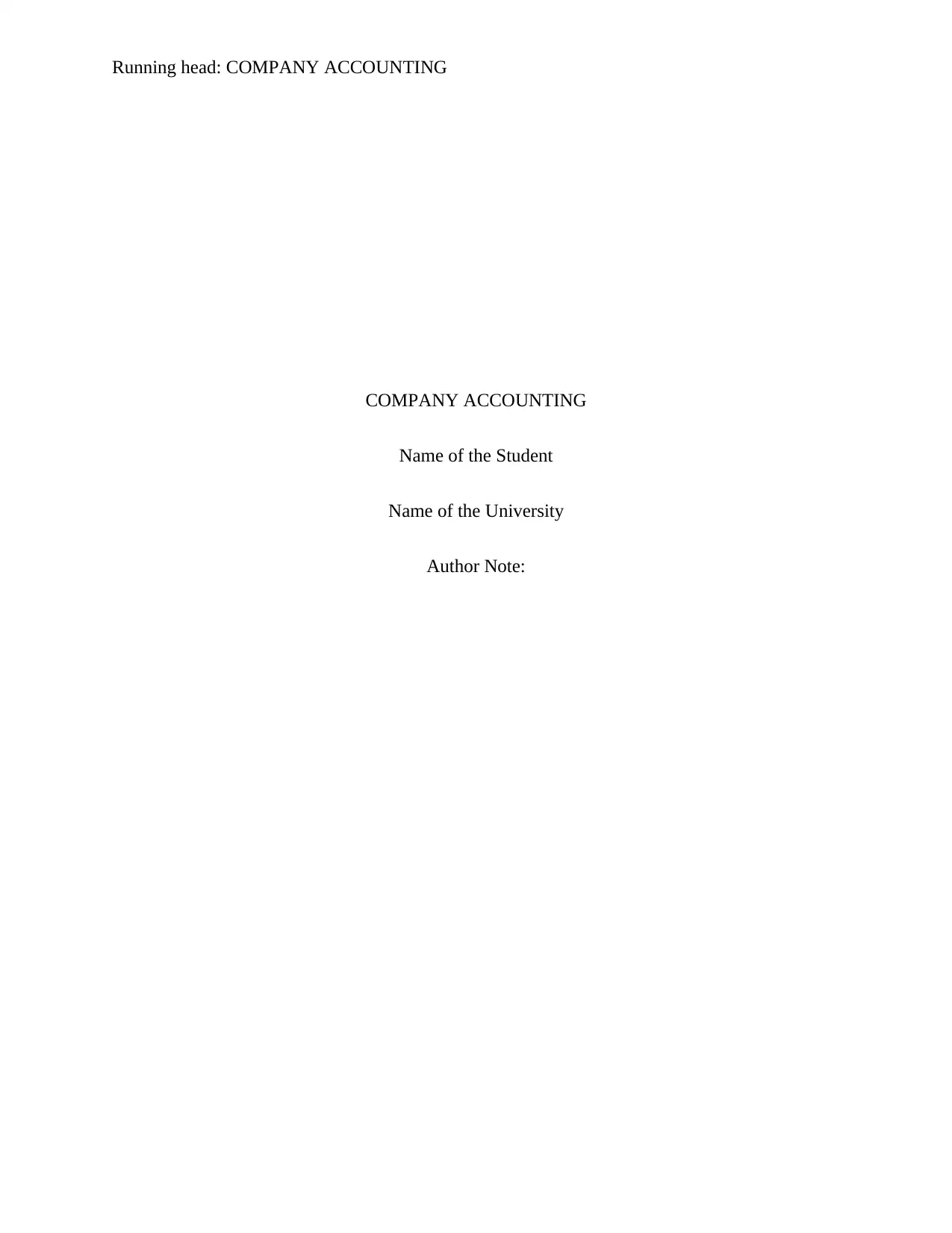
Running head: COMPANY ACCOUNTING
COMPANY ACCOUNTING
Name of the Student
Name of the University
Author Note:
COMPANY ACCOUNTING
Name of the Student
Name of the University
Author Note:
Paraphrase This Document
Need a fresh take? Get an instant paraphrase of this document with our AI Paraphraser
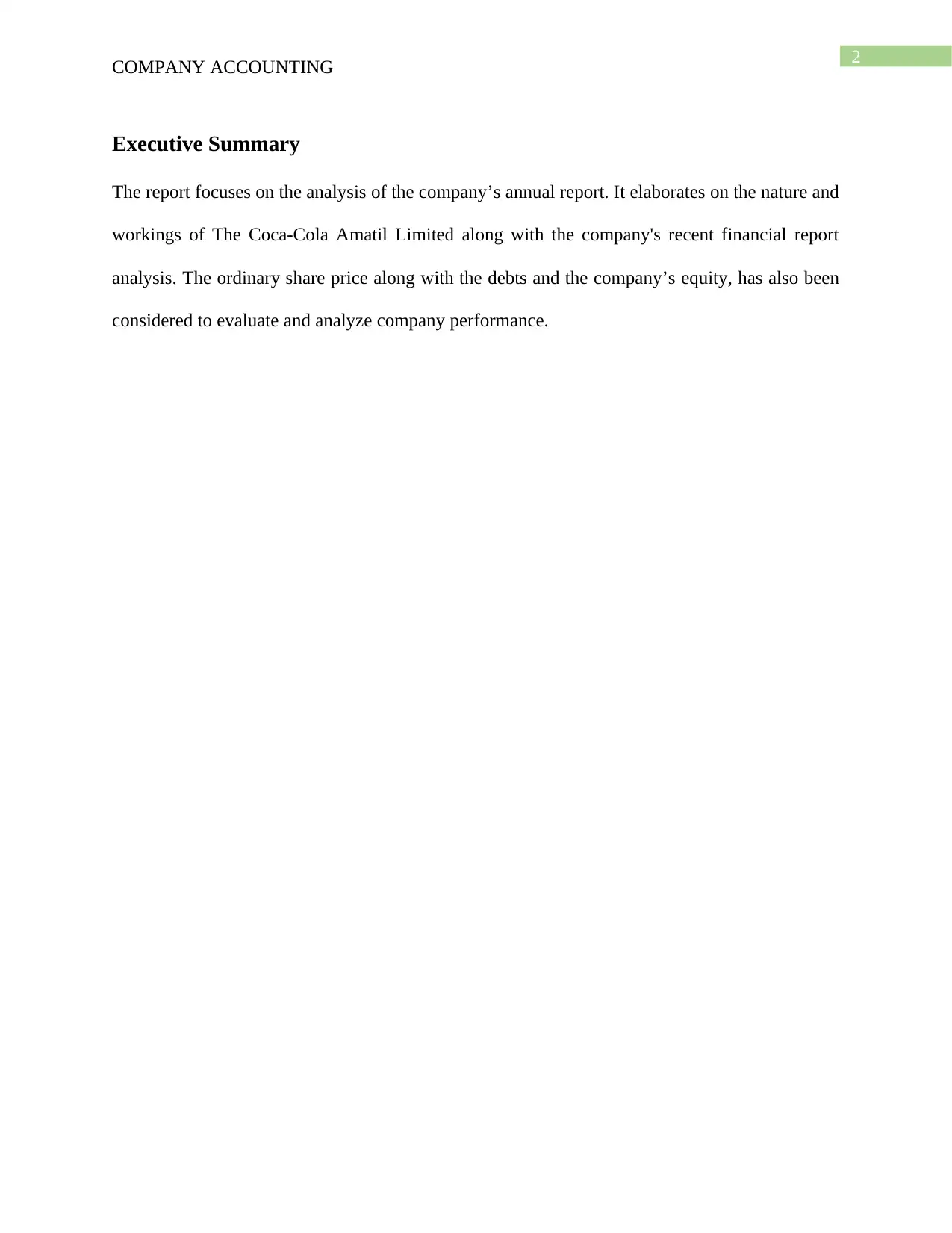
2
COMPANY ACCOUNTING
Executive Summary
The report focuses on the analysis of the company’s annual report. It elaborates on the nature and
workings of The Coca-Cola Amatil Limited along with the company's recent financial report
analysis. The ordinary share price along with the debts and the company’s equity, has also been
considered to evaluate and analyze company performance.
COMPANY ACCOUNTING
Executive Summary
The report focuses on the analysis of the company’s annual report. It elaborates on the nature and
workings of The Coca-Cola Amatil Limited along with the company's recent financial report
analysis. The ordinary share price along with the debts and the company’s equity, has also been
considered to evaluate and analyze company performance.
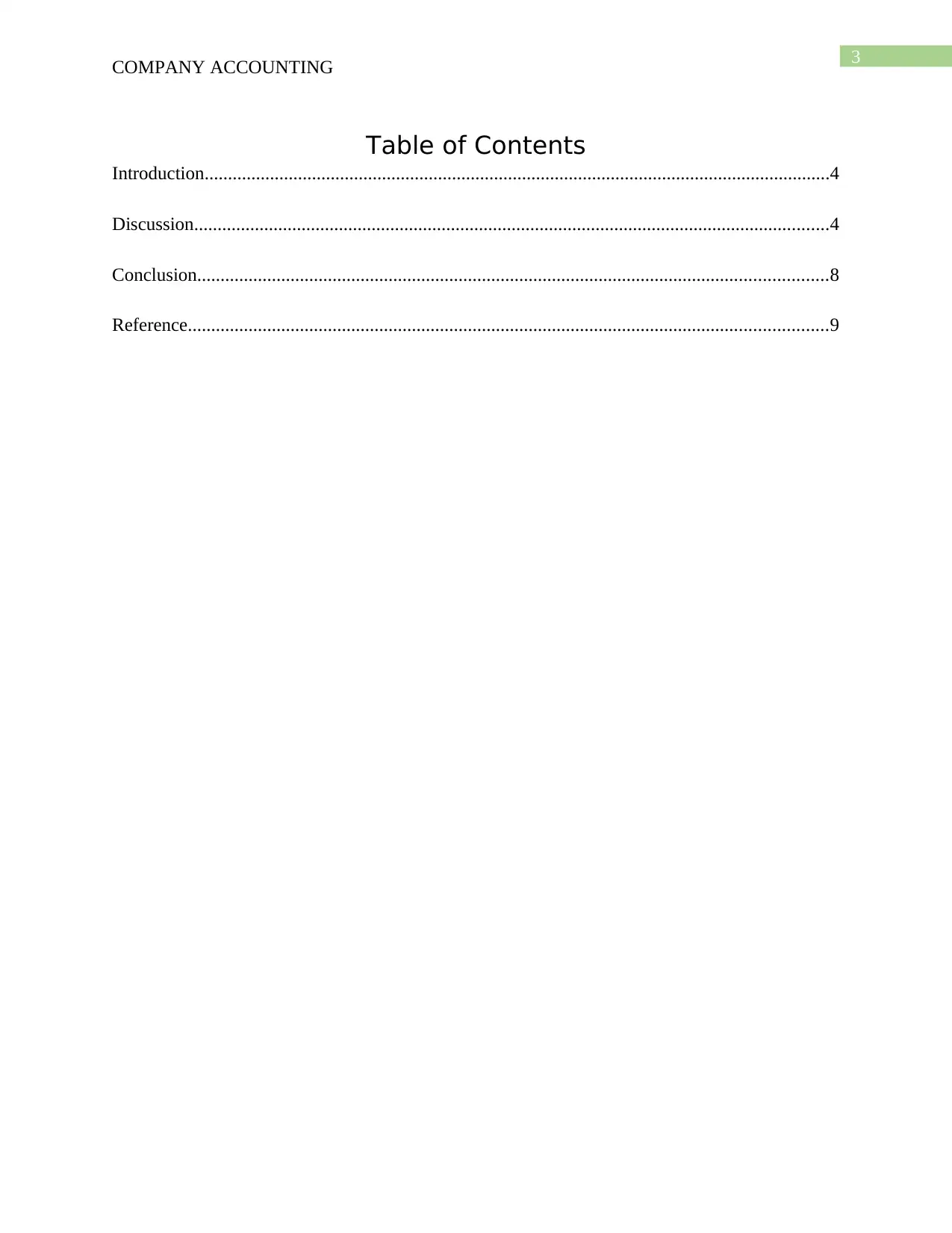
3
COMPANY ACCOUNTING
Table of Contents
Introduction......................................................................................................................................4
Discussion........................................................................................................................................4
Conclusion.......................................................................................................................................8
Reference.........................................................................................................................................9
COMPANY ACCOUNTING
Table of Contents
Introduction......................................................................................................................................4
Discussion........................................................................................................................................4
Conclusion.......................................................................................................................................8
Reference.........................................................................................................................................9
⊘ This is a preview!⊘
Do you want full access?
Subscribe today to unlock all pages.

Trusted by 1+ million students worldwide
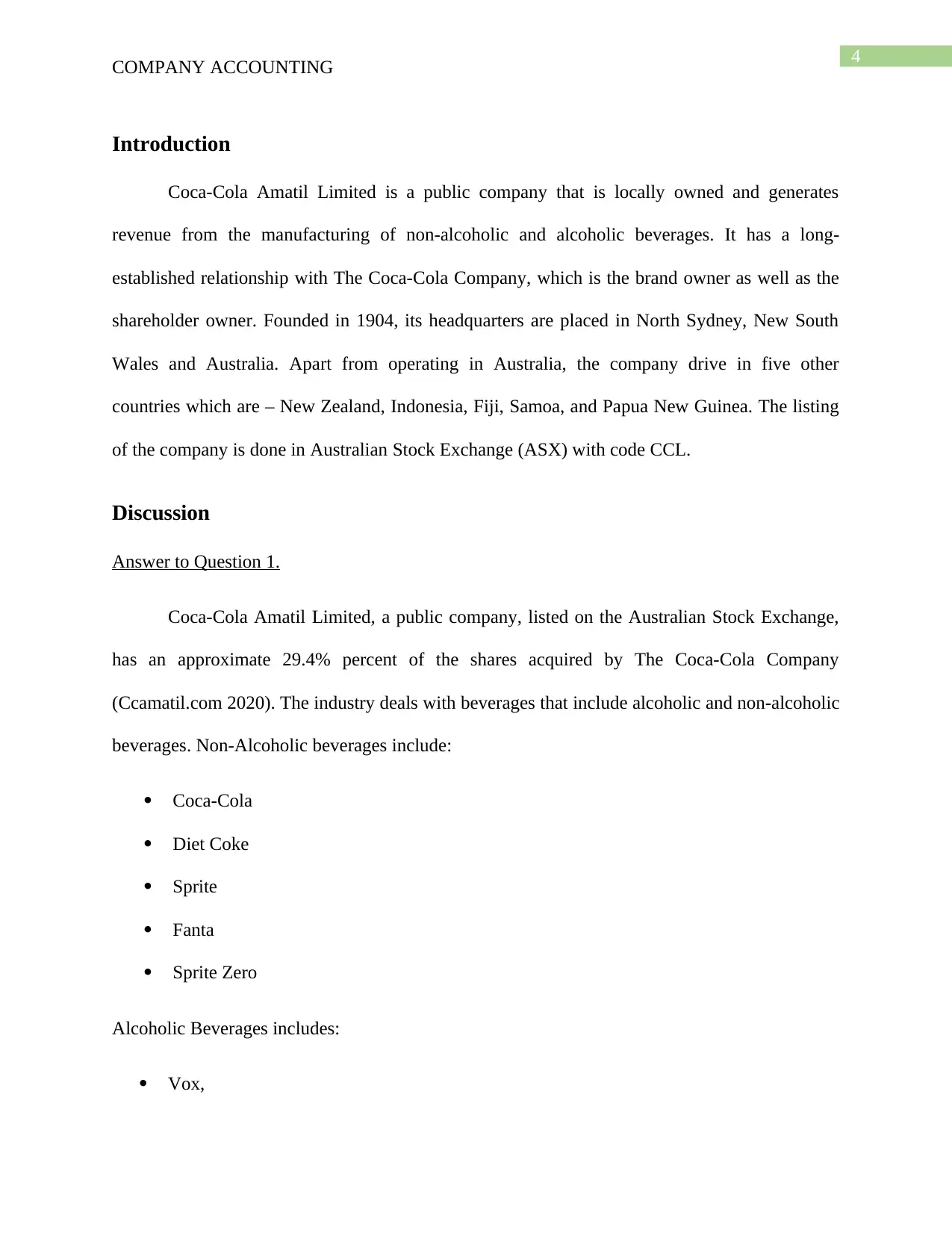
4
COMPANY ACCOUNTING
Introduction
Coca-Cola Amatil Limited is a public company that is locally owned and generates
revenue from the manufacturing of non-alcoholic and alcoholic beverages. It has a long-
established relationship with The Coca-Cola Company, which is the brand owner as well as the
shareholder owner. Founded in 1904, its headquarters are placed in North Sydney, New South
Wales and Australia. Apart from operating in Australia, the company drive in five other
countries which are – New Zealand, Indonesia, Fiji, Samoa, and Papua New Guinea. The listing
of the company is done in Australian Stock Exchange (ASX) with code CCL.
Discussion
Answer to Question 1.
Coca-Cola Amatil Limited, a public company, listed on the Australian Stock Exchange,
has an approximate 29.4% percent of the shares acquired by The Coca-Cola Company
(Ccamatil.com 2020). The industry deals with beverages that include alcoholic and non-alcoholic
beverages. Non-Alcoholic beverages include:
Coca-Cola
Diet Coke
Sprite
Fanta
Sprite Zero
Alcoholic Beverages includes:
Vox,
COMPANY ACCOUNTING
Introduction
Coca-Cola Amatil Limited is a public company that is locally owned and generates
revenue from the manufacturing of non-alcoholic and alcoholic beverages. It has a long-
established relationship with The Coca-Cola Company, which is the brand owner as well as the
shareholder owner. Founded in 1904, its headquarters are placed in North Sydney, New South
Wales and Australia. Apart from operating in Australia, the company drive in five other
countries which are – New Zealand, Indonesia, Fiji, Samoa, and Papua New Guinea. The listing
of the company is done in Australian Stock Exchange (ASX) with code CCL.
Discussion
Answer to Question 1.
Coca-Cola Amatil Limited, a public company, listed on the Australian Stock Exchange,
has an approximate 29.4% percent of the shares acquired by The Coca-Cola Company
(Ccamatil.com 2020). The industry deals with beverages that include alcoholic and non-alcoholic
beverages. Non-Alcoholic beverages include:
Coca-Cola
Diet Coke
Sprite
Fanta
Sprite Zero
Alcoholic Beverages includes:
Vox,
Paraphrase This Document
Need a fresh take? Get an instant paraphrase of this document with our AI Paraphraser
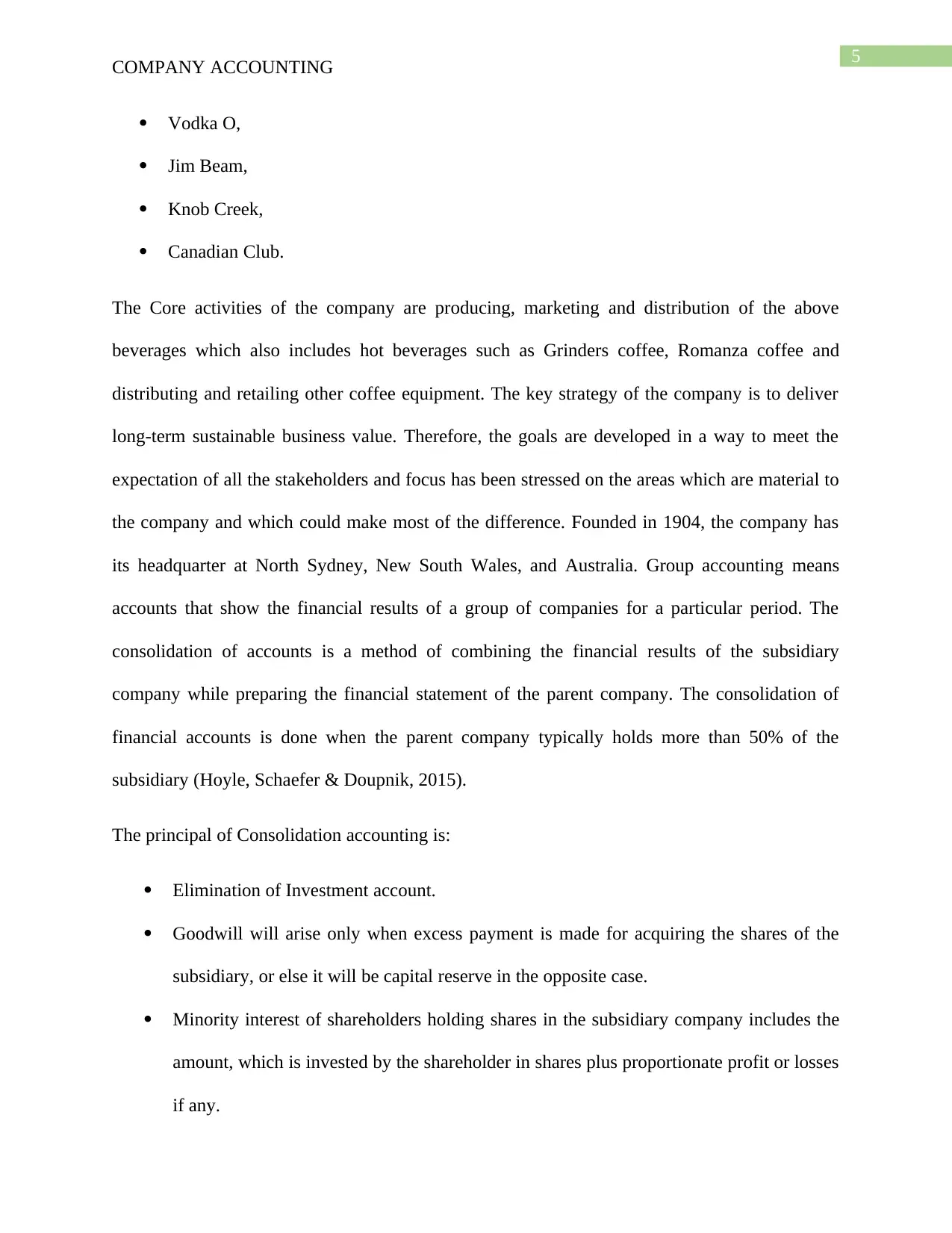
5
COMPANY ACCOUNTING
Vodka O,
Jim Beam,
Knob Creek,
Canadian Club.
The Core activities of the company are producing, marketing and distribution of the above
beverages which also includes hot beverages such as Grinders coffee, Romanza coffee and
distributing and retailing other coffee equipment. The key strategy of the company is to deliver
long-term sustainable business value. Therefore, the goals are developed in a way to meet the
expectation of all the stakeholders and focus has been stressed on the areas which are material to
the company and which could make most of the difference. Founded in 1904, the company has
its headquarter at North Sydney, New South Wales, and Australia. Group accounting means
accounts that show the financial results of a group of companies for a particular period. The
consolidation of accounts is a method of combining the financial results of the subsidiary
company while preparing the financial statement of the parent company. The consolidation of
financial accounts is done when the parent company typically holds more than 50% of the
subsidiary (Hoyle, Schaefer & Doupnik, 2015).
The principal of Consolidation accounting is:
Elimination of Investment account.
Goodwill will arise only when excess payment is made for acquiring the shares of the
subsidiary, or else it will be capital reserve in the opposite case.
Minority interest of shareholders holding shares in the subsidiary company includes the
amount, which is invested by the shareholder in shares plus proportionate profit or losses
if any.
COMPANY ACCOUNTING
Vodka O,
Jim Beam,
Knob Creek,
Canadian Club.
The Core activities of the company are producing, marketing and distribution of the above
beverages which also includes hot beverages such as Grinders coffee, Romanza coffee and
distributing and retailing other coffee equipment. The key strategy of the company is to deliver
long-term sustainable business value. Therefore, the goals are developed in a way to meet the
expectation of all the stakeholders and focus has been stressed on the areas which are material to
the company and which could make most of the difference. Founded in 1904, the company has
its headquarter at North Sydney, New South Wales, and Australia. Group accounting means
accounts that show the financial results of a group of companies for a particular period. The
consolidation of accounts is a method of combining the financial results of the subsidiary
company while preparing the financial statement of the parent company. The consolidation of
financial accounts is done when the parent company typically holds more than 50% of the
subsidiary (Hoyle, Schaefer & Doupnik, 2015).
The principal of Consolidation accounting is:
Elimination of Investment account.
Goodwill will arise only when excess payment is made for acquiring the shares of the
subsidiary, or else it will be capital reserve in the opposite case.
Minority interest of shareholders holding shares in the subsidiary company includes the
amount, which is invested by the shareholder in shares plus proportionate profit or losses
if any.
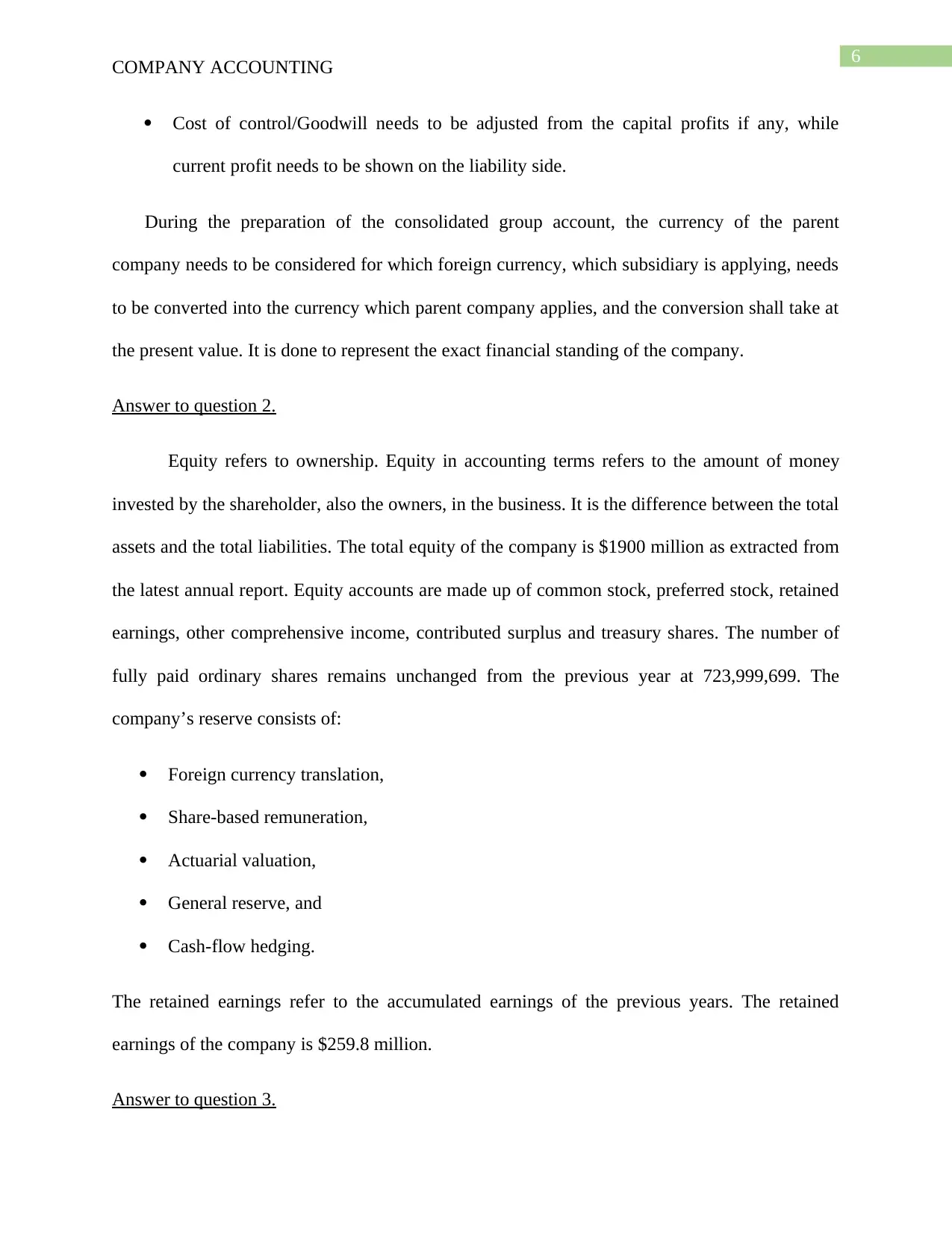
6
COMPANY ACCOUNTING
Cost of control/Goodwill needs to be adjusted from the capital profits if any, while
current profit needs to be shown on the liability side.
During the preparation of the consolidated group account, the currency of the parent
company needs to be considered for which foreign currency, which subsidiary is applying, needs
to be converted into the currency which parent company applies, and the conversion shall take at
the present value. It is done to represent the exact financial standing of the company.
Answer to question 2.
Equity refers to ownership. Equity in accounting terms refers to the amount of money
invested by the shareholder, also the owners, in the business. It is the difference between the total
assets and the total liabilities. The total equity of the company is $1900 million as extracted from
the latest annual report. Equity accounts are made up of common stock, preferred stock, retained
earnings, other comprehensive income, contributed surplus and treasury shares. The number of
fully paid ordinary shares remains unchanged from the previous year at 723,999,699. The
company’s reserve consists of:
Foreign currency translation,
Share-based remuneration,
Actuarial valuation,
General reserve, and
Cash-flow hedging.
The retained earnings refer to the accumulated earnings of the previous years. The retained
earnings of the company is $259.8 million.
Answer to question 3.
COMPANY ACCOUNTING
Cost of control/Goodwill needs to be adjusted from the capital profits if any, while
current profit needs to be shown on the liability side.
During the preparation of the consolidated group account, the currency of the parent
company needs to be considered for which foreign currency, which subsidiary is applying, needs
to be converted into the currency which parent company applies, and the conversion shall take at
the present value. It is done to represent the exact financial standing of the company.
Answer to question 2.
Equity refers to ownership. Equity in accounting terms refers to the amount of money
invested by the shareholder, also the owners, in the business. It is the difference between the total
assets and the total liabilities. The total equity of the company is $1900 million as extracted from
the latest annual report. Equity accounts are made up of common stock, preferred stock, retained
earnings, other comprehensive income, contributed surplus and treasury shares. The number of
fully paid ordinary shares remains unchanged from the previous year at 723,999,699. The
company’s reserve consists of:
Foreign currency translation,
Share-based remuneration,
Actuarial valuation,
General reserve, and
Cash-flow hedging.
The retained earnings refer to the accumulated earnings of the previous years. The retained
earnings of the company is $259.8 million.
Answer to question 3.
⊘ This is a preview!⊘
Do you want full access?
Subscribe today to unlock all pages.

Trusted by 1+ million students worldwide
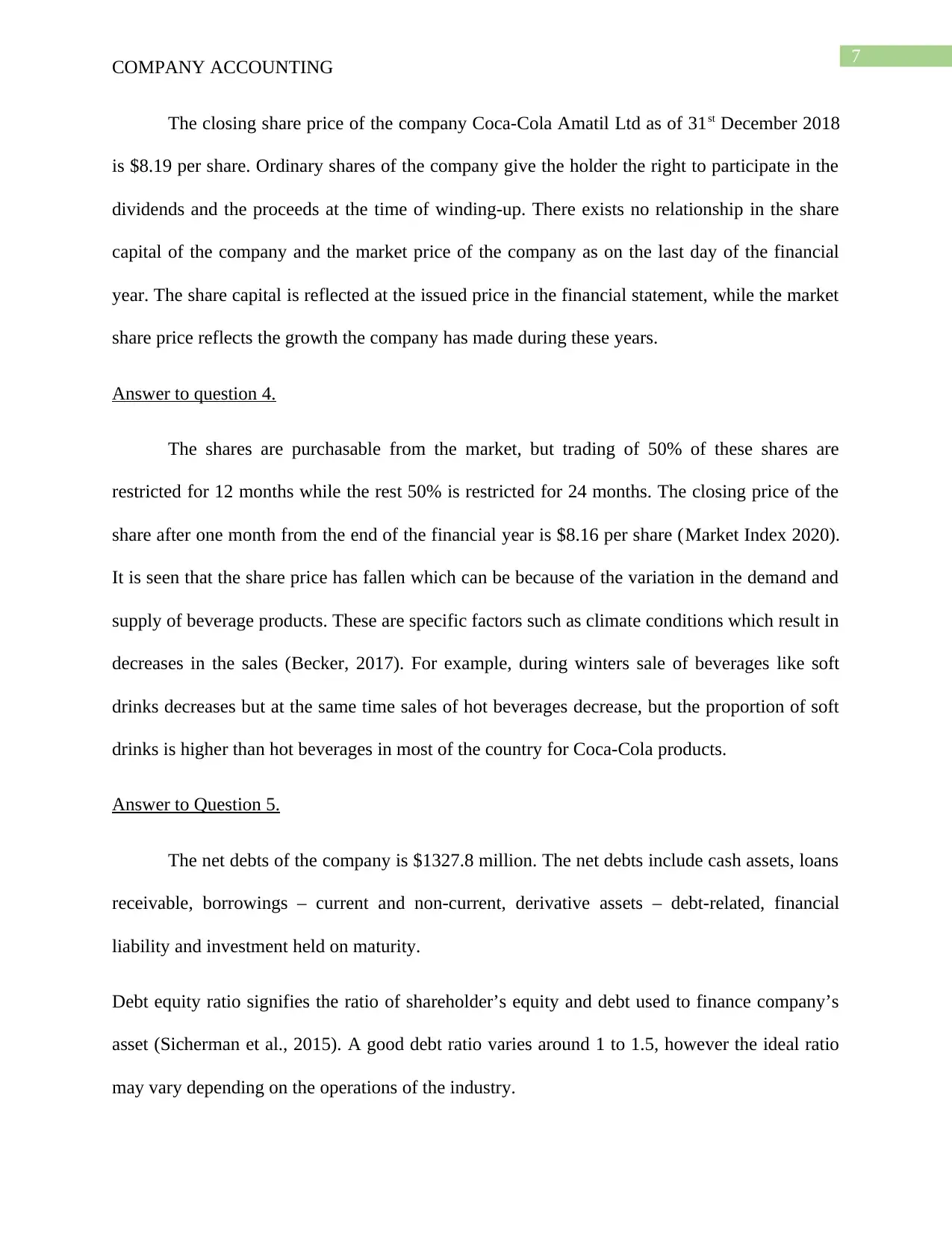
7
COMPANY ACCOUNTING
The closing share price of the company Coca-Cola Amatil Ltd as of 31st December 2018
is $8.19 per share. Ordinary shares of the company give the holder the right to participate in the
dividends and the proceeds at the time of winding-up. There exists no relationship in the share
capital of the company and the market price of the company as on the last day of the financial
year. The share capital is reflected at the issued price in the financial statement, while the market
share price reflects the growth the company has made during these years.
Answer to question 4.
The shares are purchasable from the market, but trading of 50% of these shares are
restricted for 12 months while the rest 50% is restricted for 24 months. The closing price of the
share after one month from the end of the financial year is $8.16 per share (Market Index 2020).
It is seen that the share price has fallen which can be because of the variation in the demand and
supply of beverage products. These are specific factors such as climate conditions which result in
decreases in the sales (Becker, 2017). For example, during winters sale of beverages like soft
drinks decreases but at the same time sales of hot beverages decrease, but the proportion of soft
drinks is higher than hot beverages in most of the country for Coca-Cola products.
Answer to Question 5.
The net debts of the company is $1327.8 million. The net debts include cash assets, loans
receivable, borrowings – current and non-current, derivative assets – debt-related, financial
liability and investment held on maturity.
Debt equity ratio signifies the ratio of shareholder’s equity and debt used to finance company’s
asset (Sicherman et al., 2015). A good debt ratio varies around 1 to 1.5, however the ideal ratio
may vary depending on the operations of the industry.
COMPANY ACCOUNTING
The closing share price of the company Coca-Cola Amatil Ltd as of 31st December 2018
is $8.19 per share. Ordinary shares of the company give the holder the right to participate in the
dividends and the proceeds at the time of winding-up. There exists no relationship in the share
capital of the company and the market price of the company as on the last day of the financial
year. The share capital is reflected at the issued price in the financial statement, while the market
share price reflects the growth the company has made during these years.
Answer to question 4.
The shares are purchasable from the market, but trading of 50% of these shares are
restricted for 12 months while the rest 50% is restricted for 24 months. The closing price of the
share after one month from the end of the financial year is $8.16 per share (Market Index 2020).
It is seen that the share price has fallen which can be because of the variation in the demand and
supply of beverage products. These are specific factors such as climate conditions which result in
decreases in the sales (Becker, 2017). For example, during winters sale of beverages like soft
drinks decreases but at the same time sales of hot beverages decrease, but the proportion of soft
drinks is higher than hot beverages in most of the country for Coca-Cola products.
Answer to Question 5.
The net debts of the company is $1327.8 million. The net debts include cash assets, loans
receivable, borrowings – current and non-current, derivative assets – debt-related, financial
liability and investment held on maturity.
Debt equity ratio signifies the ratio of shareholder’s equity and debt used to finance company’s
asset (Sicherman et al., 2015). A good debt ratio varies around 1 to 1.5, however the ideal ratio
may vary depending on the operations of the industry.
Paraphrase This Document
Need a fresh take? Get an instant paraphrase of this document with our AI Paraphraser
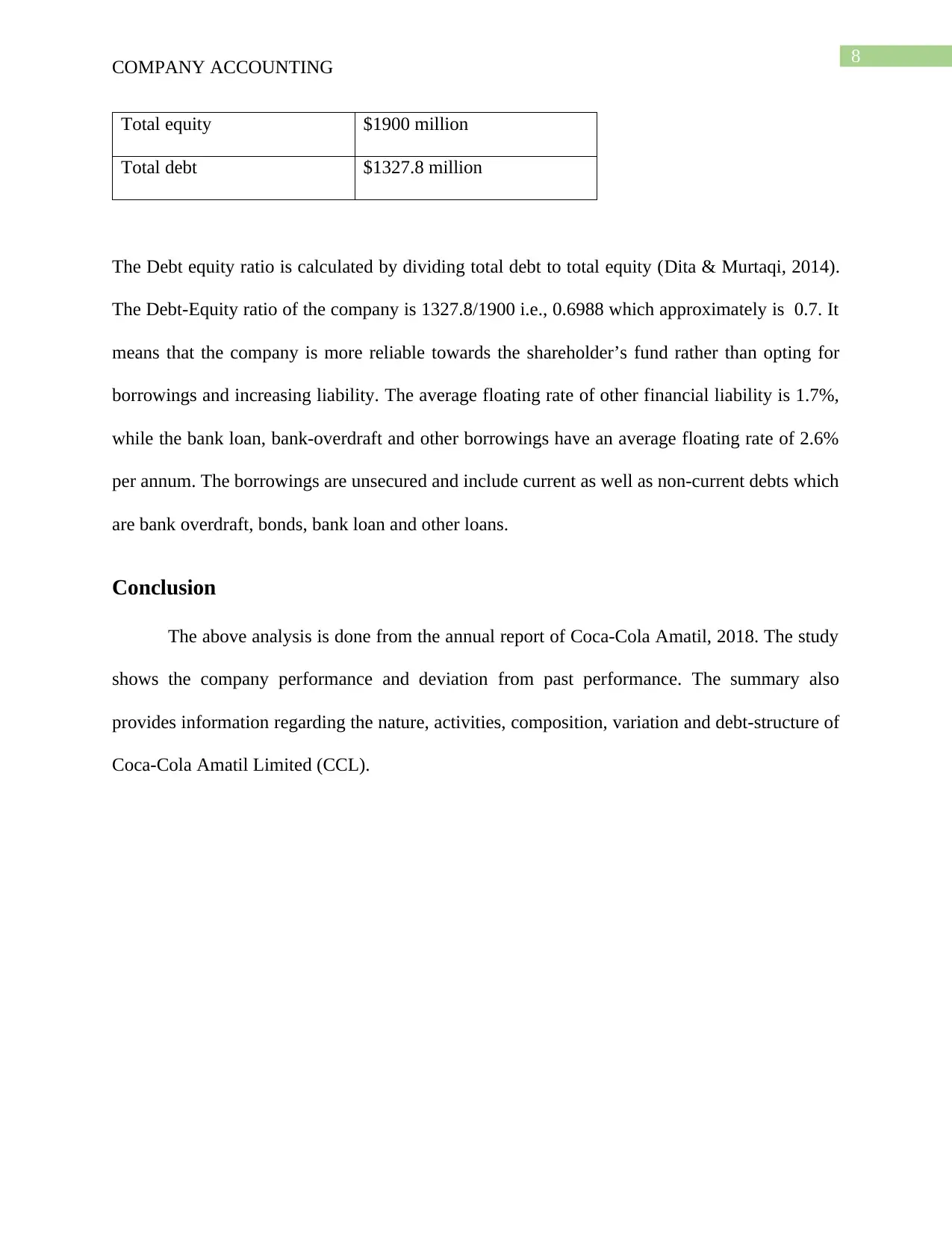
8
COMPANY ACCOUNTING
Total equity $1900 million
Total debt $1327.8 million
The Debt equity ratio is calculated by dividing total debt to total equity (Dita & Murtaqi, 2014).
The Debt-Equity ratio of the company is 1327.8/1900 i.e., 0.6988 which approximately is 0.7. It
means that the company is more reliable towards the shareholder’s fund rather than opting for
borrowings and increasing liability. The average floating rate of other financial liability is 1.7%,
while the bank loan, bank-overdraft and other borrowings have an average floating rate of 2.6%
per annum. The borrowings are unsecured and include current as well as non-current debts which
are bank overdraft, bonds, bank loan and other loans.
Conclusion
The above analysis is done from the annual report of Coca-Cola Amatil, 2018. The study
shows the company performance and deviation from past performance. The summary also
provides information regarding the nature, activities, composition, variation and debt-structure of
Coca-Cola Amatil Limited (CCL).
COMPANY ACCOUNTING
Total equity $1900 million
Total debt $1327.8 million
The Debt equity ratio is calculated by dividing total debt to total equity (Dita & Murtaqi, 2014).
The Debt-Equity ratio of the company is 1327.8/1900 i.e., 0.6988 which approximately is 0.7. It
means that the company is more reliable towards the shareholder’s fund rather than opting for
borrowings and increasing liability. The average floating rate of other financial liability is 1.7%,
while the bank loan, bank-overdraft and other borrowings have an average floating rate of 2.6%
per annum. The borrowings are unsecured and include current as well as non-current debts which
are bank overdraft, bonds, bank loan and other loans.
Conclusion
The above analysis is done from the annual report of Coca-Cola Amatil, 2018. The study
shows the company performance and deviation from past performance. The summary also
provides information regarding the nature, activities, composition, variation and debt-structure of
Coca-Cola Amatil Limited (CCL).
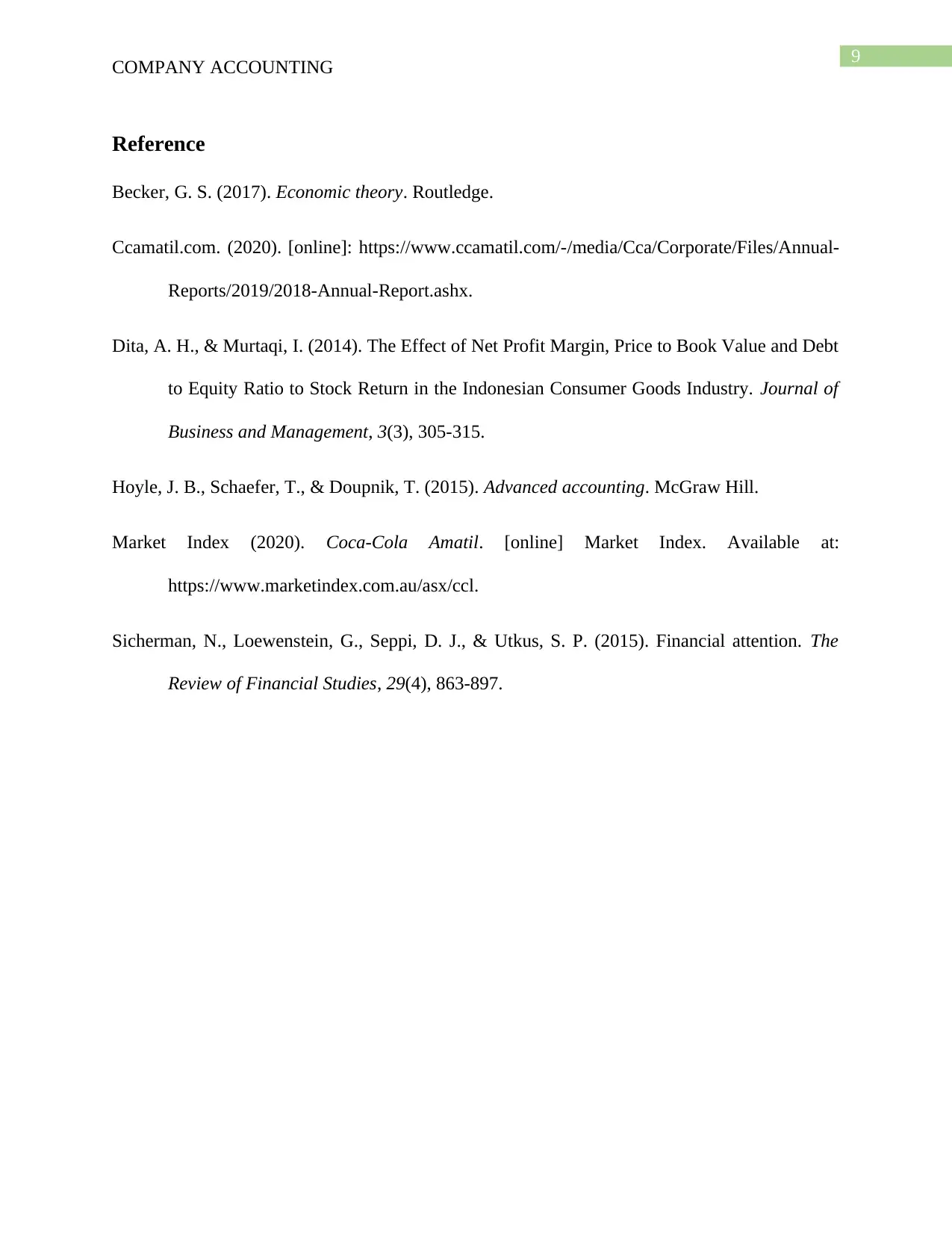
9
COMPANY ACCOUNTING
Reference
Becker, G. S. (2017). Economic theory. Routledge.
Ccamatil.com. (2020). [online]: https://www.ccamatil.com/-/media/Cca/Corporate/Files/Annual-
Reports/2019/2018-Annual-Report.ashx.
Dita, A. H., & Murtaqi, I. (2014). The Effect of Net Profit Margin, Price to Book Value and Debt
to Equity Ratio to Stock Return in the Indonesian Consumer Goods Industry. Journal of
Business and Management, 3(3), 305-315.
Hoyle, J. B., Schaefer, T., & Doupnik, T. (2015). Advanced accounting. McGraw Hill.
Market Index (2020). Coca-Cola Amatil. [online] Market Index. Available at:
https://www.marketindex.com.au/asx/ccl.
Sicherman, N., Loewenstein, G., Seppi, D. J., & Utkus, S. P. (2015). Financial attention. The
Review of Financial Studies, 29(4), 863-897.
COMPANY ACCOUNTING
Reference
Becker, G. S. (2017). Economic theory. Routledge.
Ccamatil.com. (2020). [online]: https://www.ccamatil.com/-/media/Cca/Corporate/Files/Annual-
Reports/2019/2018-Annual-Report.ashx.
Dita, A. H., & Murtaqi, I. (2014). The Effect of Net Profit Margin, Price to Book Value and Debt
to Equity Ratio to Stock Return in the Indonesian Consumer Goods Industry. Journal of
Business and Management, 3(3), 305-315.
Hoyle, J. B., Schaefer, T., & Doupnik, T. (2015). Advanced accounting. McGraw Hill.
Market Index (2020). Coca-Cola Amatil. [online] Market Index. Available at:
https://www.marketindex.com.au/asx/ccl.
Sicherman, N., Loewenstein, G., Seppi, D. J., & Utkus, S. P. (2015). Financial attention. The
Review of Financial Studies, 29(4), 863-897.
⊘ This is a preview!⊘
Do you want full access?
Subscribe today to unlock all pages.

Trusted by 1+ million students worldwide
1 out of 9
Related Documents
Your All-in-One AI-Powered Toolkit for Academic Success.
+13062052269
info@desklib.com
Available 24*7 on WhatsApp / Email
![[object Object]](/_next/static/media/star-bottom.7253800d.svg)
Unlock your academic potential
Copyright © 2020–2025 A2Z Services. All Rights Reserved. Developed and managed by ZUCOL.




